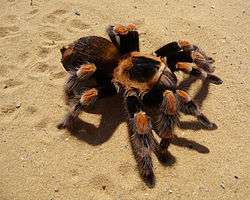Brachypelma
| Brachypelma | |
|---|---|
 | |
| Female Mexican red-knee tarantula, B. smithi in captivity | |
| Scientific classification | |
| Kingdom: | Animalia |
| Phylum: | Arthropoda |
| Subphylum: | Chelicerata |
| Class: | Arachnida |
| Order: | Araneae |
| Infraorder: | Mygalomorphae |
| Family: | Theraphosidae |
| Genus: | Brachypelma Simon, 1891[1] |
| Species | |
|
See text. | |
| Diversity[1] | |
| 19 species | |
| Synonyms | |
|
Brachypelmides Schmidt & Krause, 1994 | |
Brachypelma is a genus of the family Theraphosidae containing several species of tarantulas.
Characteristics
The species are native to Mexico and neighboring countries of Central America. Habitat destruction and pet-trade collection have led these spiders to be among the few arthropods protected under the international Convention on International Trade of Endangered Species rules. They are docile tarantulas which are easy to keep in a terrarium. The most famous species in this genus are the Mexican redknee tarantula B. smithi, curlyhair B. albopilosum, and the Mexican redrump B. vagans. They feed on smaller invertebrates and occasionally vertebrates, but while insects are the norm, they may also eat lizards or frogs. These species, like most tarantulas, are cannibalistic, so in captivity, individuals must be kept singly, though brief captive introductions of a mate for breeding purposes can prove unproblematic, so long as they are separated once mating has occurred.
Lifecycle
These spiders are relatively slow-growing compared to other tarantulas, and have impressive lifespans around 20 years for females. After hatching from a clutch that may vary from 300 to 1200+ eggs, the spiderlings molt every two weeks for the first few months, then less frequently as they mature. A full-grown Brachypelma may molt as infrequently as once a year. These tarantulas reach sexual maturity around five years old.
Large spiders used in Hollywood movies (e.g. Indiana Jones series, The Mummy Returns) are often Brachypelma smithi or Brachypelma emilia because they are very docile, though the much less expensive and only moderately more aggressive Chilean rose tarantula is frequently used, as well. While it is almost unheard of for a Brachypelma to bite a human, they are quick to kick urticating hairs in self defense, though their hairs can be less irritating than those of other species, especially the goliath birdeater.
Species
As of March 2016, the World Spider Catalog accepted the following species:[1]
- Brachypelma albiceps Pocock, 1903 – Mexico
- Brachypelma albopilosum Valerio, 1980 – Costa Rica
- Brachypelma andrewi Schmidt, 1992 – Unknown
- Brachypelma annitha Tesmoingt, Cleton & Verdez, 1997 – Mexico
- Brachypelma auratum Schmidt, 1992 – Mexico
- Brachypelma aureoceps (Chamberlin, 1917) – USA (probably introduced)
- Brachypelma baumgarteni Smith, 1993 – Mexico
- Brachypelma boehmei Schmidt & Klaas, 1993 – Mexico
- Brachypelma emilia (White, 1856) (type species) – Mexico
- Brachypelma epicureanum (Chamberlin, 1925) – Mexico
- Brachypelma fossorium Valerio, 1980 – Costa Rica
- Brachypelma hamorii Tesmoingt, Cleton & Verdez, 1997 – Mexico
- Brachypelma kahlenbergi Rudloff, 2008 – Mexico
- Brachypelma klaasi (Schmidt & Krause, 1994) – Mexico
- Brachypelma sabulosum (F. O. Pickard-Cambridge, 1897) – Guatemala
- Brachypelma schroederi Rudloff, 2003 – Mexico
- Brachypelma smithi (F. O. Pickard-Cambridge, 1897) – Mexico
- Brachypelma vagans (Ausserer, 1875) – Mexico, Central America
- Brachypelma verdezi Schmidt, 2003 – Mexico
Two species have been moved to the genus Sericopelma:[1]
- Brachypelma angustum Valerio, 1980 → Sericopelma angustum
- Brachypelma embrithes (Chamberlin & Ivie, 1936) → Sericopelma embrithes
See also
- Pinktoe tarantula
- Chilean rose tarantula
- Avicularia
- Goliath birdeater
- Brazilian whiteknee tarantula
- Cobalt blue tarantula
References
- 1 2 3 4 "Gen. Brachypelma Simon, 1891", World Spider Catalog, Natural History Museum Bern, retrieved 2016-03-27
External links
- CITES Species database
- 14 Brachypelma species in gallery of tarantulas.
- Brachypelma.org
- www.wildtarantulas.com Brachypelma in the wild